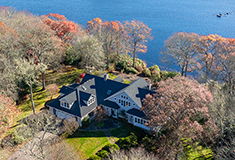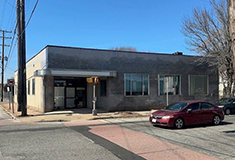News:
Rhode Island
Posted: May 6, 2009
The green reincarnation of old New England buildings
One of the greenest strategies in the building industry's toolbox is to reuse existing stock and give an old structure a second life as a green building. This capitalizes on its embodied energy (the energy it took to build it in the first place) instead of using more energy to tear it down. With New England's large inventory of great old buildings, there are more and more green makeovers underway.
Tony Dematteo, vice president of business Development at Dimeo Construction Co. and USGBC-RI board member, says about 50% of their projects are in existing structures.
"The most important thing in greening an existing building is looking at how the building reacts to the outside environment, how insulation and window systems work and how efficient it is in terms of BTU consumption to reduce the carbon load we're putting into the atmosphere. There is a lot of focus on high efficiency heating and cooling systems and creating window/wall systems that shed the solar load, instead of adding to the cooling load," Dematteo said.
Some green strategies employed include boosting insulation for a tighter building envelope, improving glass coatings to keep heat out in the summer and reduce A/C consumption, and maximizing use of daylight with interior walls that reflect light to reduce the need for electrical light. Dimming controls and motion sensors reduce energy consumption. An easy choice is using a lot of recycled materials and products with low Volatile Organic Compounds (VOCs) for better air quality.
The roof is also an important factor, Dematteo said. Use lighter color rubber membranes that reflect solar gain and control runoff, install rainwater collection and reuse systems, or look into green vegetative roofing to reflect heat and absorb rain.
"We're getting a lot of requests for geothermal and photovoltaics, too," Dematteo said. "People are starting to think of green building as a long range investment with a huge payback. And the construction industry is totally on board. At Dimeo we have 30 LEED Accredited Professionals, and everyone is trained in sustainable construction."
Jack Leyden agrees the green tide has turned. He is a USGBC-RI board member and the RI State Building Code commissioner. Rhode Island adopted new air barrier requirements over and above the national code for tighter building envelopes, which were mandatory on 4/1/09.
"There was no resistance to the new code: architects, engineers, and builders have all been in favor as we travel the state offering educational programs. And not a single person spoke against them at the public hearings," Leyden said.
In some cases, new building codes can help drive increased green behavior. Whether renovation or new construction, if you need a building permit you'll need to meet the state code.
"It starts with the plan review, to make sure they meet the energy code, before they can get their building permit. Then when construction begins, inspections ensure they meet the minimum codes," Leyden said.
Leyden is also on the USGBC-RI Advocacy Committee, advising the Governor to adopt new legislation for energy codes. "There is federal stimulus money available for states who adopt the most recent International Energy Codes from the ICC (International Code Council), which we are in the process of doing anyway. We are in tune with the issues."
Leyden and the Building Code Commission are in the process of reading through the recently published IEC codes to determine exactly what they call for. "It's too early to tell, but I would estimate there's a minimum of 10 - 20% more efficiency built in."
So a year from now, we could be looking at even greener codes and more earth-friendly renovations.
Diane Sterrett is owner of Sterrett Copy and Creative, Tiverton, RI.
Tags:
Rhode Island
MORE FROM Rhode Island
Washington Trust named one of healthiest employers in Rhode Island by PBN
Westerly, RI For the fourth year in a row, Washington Trust has been named by Providence Business News (PBN) as one of the healthiest employers in Rhode Island. Washington Trust was one of 27 organizations selected for PBN’s 2025 Healthiest Employers Awards,

Quick Hits
Columns and Thought Leadership

Warwick offers convenience of city living, but feels like a smaller, close-knit community - by Frank Picozzi
Located in the heart of southern New England, Warwick is a perfect community in which to locate your business, or find a spot to develop commercial and residential projects. Warwick brings the convergence of air, rail, highway, and maritime travel in one convenient, central location. We’re home to Rhode Island T.F. Green

Nine Post Rd. receives approval for six units and commercial space - by Frank Picozzi
After several years of planning, the owners of a property in historic Pawtuxet Village recently received planning board master plan approval for a mixed-use building consisting of six residential units and 1,510 s/f of commercial space along the banks of the majestic Pawtuxet River.

Diverse mix of businesses makes Warwick the perfect community - by Frank Picozzi
For those looking for some recreation in the great outdoors, wooded trails and biking paths with spectacular water views, lush green grass perfect for a picnic, fun playgrounds with all the amenities, and modern sports fields can be found easily throughout Warwick. But what does one do when the

The City of Warwick is the perfect choice - by Frank Picozzi
The late summer sky was bright and the mood festive at the family-friendly “Best in Town” event at Rhode Island’s first Floor & Décor store. Those looking to make some home improvements strolled through the warehouse, admiring the well-stocked aisles, fair

.png)





.png)


.png)
